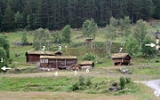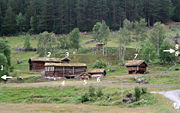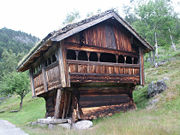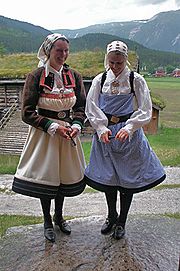
Rygnestadtunet
Encyclopedia


Museum
A museum is an institution that cares for a collection of artifacts and other objects of scientific, artistic, cultural, or historical importance and makes them available for public viewing through exhibits that may be permanent or temporary. Most large museums are located in major cities...
at Nordigard, Nørdre Rygnestad
Rygnestad
Rygnestad is a village in the municipality of Valle in Aust-Agder county, Norway. It is located in the Setesdal region near the river Otra in northern Valle near the lake Store Bjørnevatn. It is about north of the municipal center of Valle. The Rygnestadtunet museum is located just north of the...
in the municipality of Valle in the Setesdal
Setesdal
Setesdal is a valley and a traditional district in Aust-Agder County in southern Norway. It consists of the municipalities of Bykle, Valle, Bygland, Iveland, and Evje og Hornnes....
region of Aust-Agder
Aust-Agder
is a county in Norway, bordering Telemark, Rogaland, and Vest-Agder. In 2002, there were 102,945 inhabitants, which is 2.2% of the total population in Norway. Its area is . The administrative center of the county is in Arendal....
, Norway
Norway
Norway , officially the Kingdom of Norway, is a Nordic unitary constitutional monarchy whose territory comprises the western portion of the Scandinavian Peninsula, Jan Mayen, and the Arctic archipelago of Svalbard and Bouvet Island. Norway has a total area of and a population of about 4.9 million...
. It's located near the junction between highways 9 and 45. The farm museum today looks exactly as it did when it was deserted in 1919 and preserved in 1923. It was opened as a museum in 1940. Excavations in the area indicate that the site has been populated since at least 900 AD.
Rygnestadtunet is an authentic farmyard consisting of a brook mill (1), farmhouse (2), storehouse ("loft") built in three stories (3), barn and stable (4), sheephouse (5), barn (6), storehouse on pillars ("loft") (7), blacksmiths workshop (8), and sauna (9). (See the picture to the right for view of each building.) The custom of building a separate house for each purpose was common in the Setesdal
Setesdal
Setesdal is a valley and a traditional district in Aust-Agder County in southern Norway. It consists of the municipalities of Bykle, Valle, Bygland, Iveland, and Evje og Hornnes....
valley until the beginning of the World War II
World War II
World War II, or the Second World War , was a global conflict lasting from 1939 to 1945, involving most of the world's nations—including all of the great powers—eventually forming two opposing military alliances: the Allies and the Axis...
. The museum farmyard is only including the old farmyard. The new Nordigard Rygnestad farmyard is situated just below the old one.
Rygnestadloftet
The most noted of the buildings is Rygnestadloftet, a storehouse on pillars, built in two stories by Vonde-ÅsmundVonde-Åsmund
Vond-Åsmund Rygnestad or Åsmund the evil, is a legend in the history of Setesdal. He built and lived at the farm Rygnestadstunet. The legend states that he was blond, handsome, well built - strong and vigorous. The legend also tells that he had great courage, he was proud and bold, smart, literate,...
(Åsmund the Evil) (1540-1596) in 1590. Rygnestadloftet is highly valued for its fine proportions, its good craftmaship and use of exquisite materials. The cog joint timber has considerable dimensions. The with of one timber log is enough for the height of the entrance door.
According to the tradition, Rygnestaloftet was also designed for defense, and has served its purpose by some occasions. In the ground floor there is a little shutter covering an opening leading to an escape tunnel ending in a grove some twenty yards above. The ground floor was used for storing food supplies. There is also a bed. The second floor was used for clothes, textiles and valuables. It had an external gallery. On the rear there was built an annex for a so called "secret", an outhouse, ending on the open ground below. In Setesdal no other example is known of a similar construction.
Farmhouse

Black Death
The Black Death was one of the most devastating pandemics in human history, peaking in Europe between 1348 and 1350. Of several competing theories, the dominant explanation for the Black Death is the plague theory, which attributes the outbreak to the bacterium Yersinia pestis. Thought to have...
1349-1350 or possibly from the 13th century. To the right of the entrance is the "nystog". It was rebuilt and fitted with fireplace and chimney. The chimey made it possible to build another storey on top. In the front of the building there originally was an external gallery. To make the ridge roof on a level and make it possible to use of the room of the staircase, the headroom in "gammelstog" was extended accordingly. "Nystog" was used for everyday life and lighter cooking, while "gammelstog" served as scullery. Both rooms were used for sleeping.
Old loft
"Trihågloptet" is a unique construction. Its name is a local expression meaning "the storehouse in three stories". As the name indicates it is erected in three stories. Storehouses on pillars was anyway, whithout exception, built in two stories. "Trihågloptet" was built from the top and downwards. The upper, the cog jointed part—the third storey—was built on cantilevered logs protruding from the second storey in the farmhouse. Later on, presumably after a short time, the two lower storeys were added—not in cog jointed logs—but built in a lighter construction. On the ground floor it had beds connected to the wall, but was otherwise it was used as a storage for food and clothes.Other buildings
The other farmbuildings, as the little water millGristmill
The terms gristmill or grist mill can refer either to a building in which grain is ground into flour, or to the grinding mechanism itself.- Early history :...
, barn
Barn
A barn is an agricultural building used for storage and as a covered workplace. It may sometimes be used to house livestock or to store farming vehicles and equipment...
and stable
Stable
A stable is a building in which livestock, especially horses, are kept. It most commonly means a building that is divided into separate stalls for individual animals...
, sheepshed, cowshed, are built principally in the 19th century. The cowshed and the sheepshed is located close to the fodder outlet on the left side of the barn. Just after the turn of the century, the buildings were undergoing a modernization. Another storey was added to the barn and the stable was included in the building. Earlier the stable had been a separate building under its own roof. Traces from the old ways of operation are clearly visible in the buildings.
Buildings like the blacksmiths workshop and sauna was located at some distance from the other buildings due to the inherent risk of catch a spreading fire. The sauna was also used for drying grain and smoking of meat.

